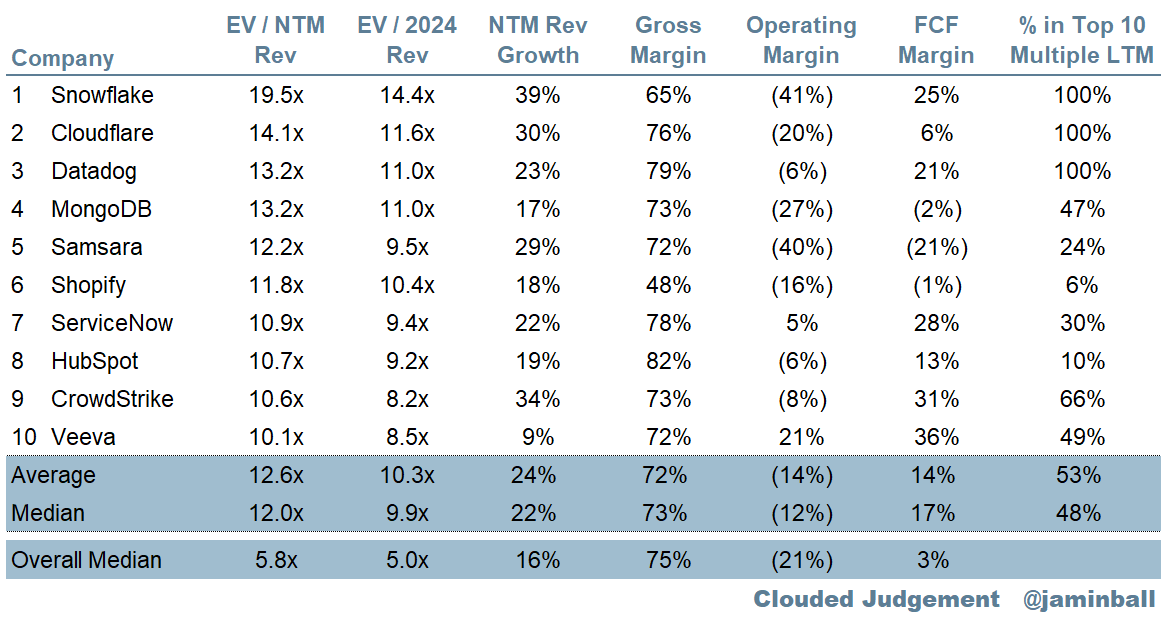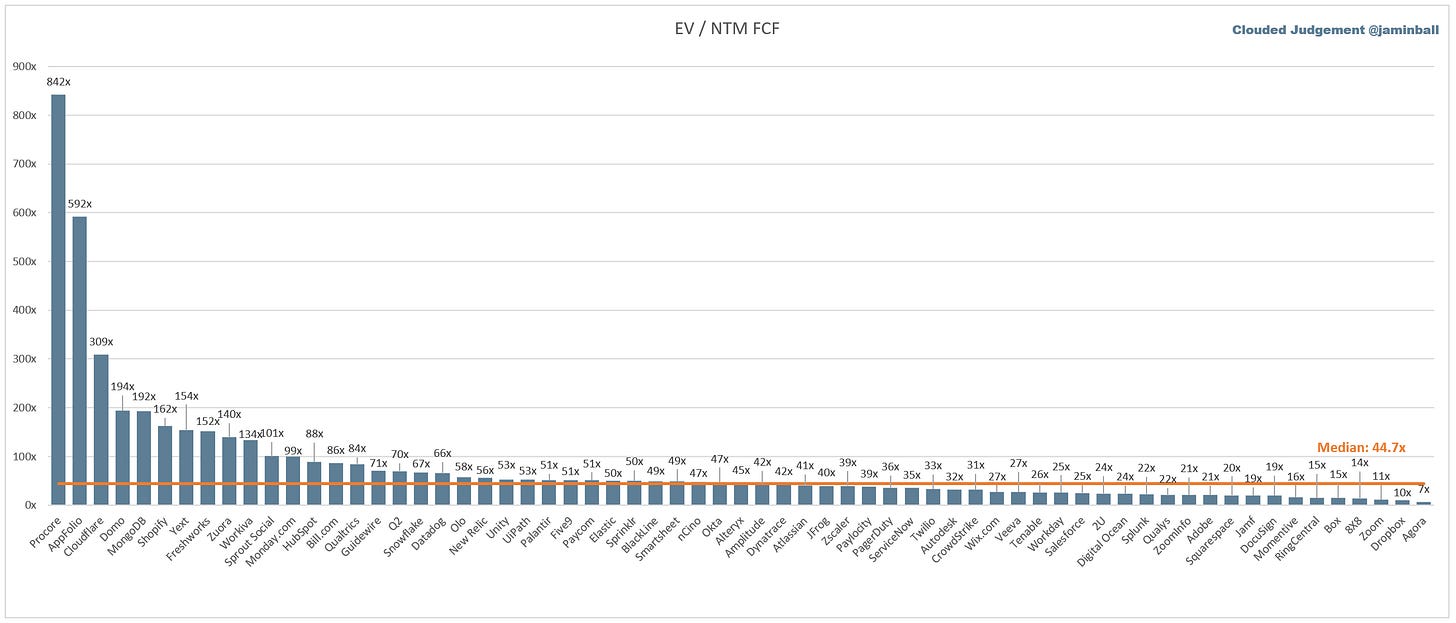Clouded Judgement 5.19.23 - Reflections on Q1 Earnings
Every week I’ll provide updates on the latest trends in cloud software companies. Follow along to stay up to date!
Reflections on Software Performance in Q1
Software stocks have enjoyed quite the run this year. Medium and high growth software companies have seen a median stock price performance this year of 21% and 26% respectively. Meanwhile, the Nasdaq is up >20%. Have public software companies started to turn a corner? When we look at the operating performance, it paints a less-rosy picture. Investors are either looking forward to better times coming soon, or results are simply better than feared (or both). Let’s look at some operating stats.
Important to call out - figures for Q1 ‘23 only include companies who have reported Q1 earnings (this excludes companies with April quarter ends who haven’t reported yet). So the comparrisons from Q1 ‘23 to prior years isn’t totally apples to apples (but the median figure should be directionally accurate for Q1 ‘23)
First - net new ARR added. As I’ve mentioned before, calculating net new ARR added in a quarter for public companies is a bit of a swag since not all companies report ARR. For those who don’t, I’m using quarterly subscription revenue x4 to estimate ARR. The chart below shows Q1 ‘23 net new ARR added vs the quarterly average across the 4 quarters in 2022. In normal times, you’d expect the Q1 ‘23 net new ARR to be >> than the quarterly average across 2022 (so a positive figure). As you can see, the majority of companies added less net new ARR in Q1 ‘23 than they did on average last year. The median was a drop of 24%! 5 companies even saw their overall ARR shrink from Q4 ‘22 to Q1 ‘23 (Zoominfo, Fastly, BlackLine, Dropbox, Twilio). This tells me new bookings still present a headwind (and we’re not seeing improvements yet)
Second - Quarterly revenue growth. As you can imagine, we saw a steeper drop off in the median YoY growth rate in Q1 ‘23. We’re close to dipping below 20%. The rate of change also accelerated in Q1 (ie the rate of decel increased)
Third - Net Retention. The median net retention in Q1 ‘23 also really fell of dramatically. This is not surprising given all of the commentary we’ve heard on headwinds to expansion bookings
Fourth - CAC Payback. The median CAC payback period is also going up. It’s getting harder and harder to close new business
Fifth - FCF Margin. The bright spot! As we’ve seen across the board, a renewed focus on efficiency is driving FCF margins higher. We’re almost to 10% median FCF margins across the cloud software universe
Quarterly Reports Summary
Top 10 EV / NTM Revenue Multiples
Top 10 Weekly Share Price Movement
Update on Multiples
SaaS businesses are generally valued on a multiple of their revenue - in most cases the projected revenue for the next 12 months. Revenue multiples are a shorthand valuation framework. Given most software companies are not profitable, or not generating meaningful FCF, it’s the only metric to compare the entire industry against. Even a DCF is riddled with long term assumptions. The promise of SaaS is that growth in the early years leads to profits in the mature years. Multiples shown below are calculated by taking the Enterprise Value (market cap + debt - cash) / NTM revenue.
Overall Stats:
Overall Median: 5.8x
Top 5 Median: 13.2x
10Y: 3.6%
Bucketed by Growth. In the buckets below I consider high growth >30% projected NTM growth, mid growth 15%-30% and low growth <15%
High Growth Median: 9.0x
Mid Growth Median: 7.0x
Low Growth Median: 3.3x
EV / NTM FCF
Companies with negative NTM FCF are not listed on the chart
Scatter Plot of EV / NTM Rev Multiple vs NTM Rev Growth
How correlated is growth to valuation multiple?
Growth Adjusted EV / NTM Rev
The below chart shows the EV / NTM revenue multiple divided by NTM consensus growth expectations. The goal of this graph is to show how relatively cheap / expensive each stock is relative to their growth expectations
Operating Metrics
Median NTM growth rate: 16%
Median LTM growth rate: 25%
Median Gross Margin: 75%
Median Operating Margin (21%)
Median FCF Margin: 3%
Median Net Retention: 115%
Median CAC Payback: 38 months
Median S&M % Revenue: 46%
Median R&D % Revenue: 27%
Median G&A % Revenue: 18%
Comps Output
Rule of 40 shows rev growth + FCF margin (both LTM and NTM for growth + margins). FCF calculated as Cash Flow from Operations - Capital Expenditures
GM Adjusted Payback is calculated as: (Previous Q S&M) / (Net New ARR in Q x Gross Margin) x 12 . It shows the number of months it takes for a SaaS business to payback their fully burdened CAC on a gross profit basis. Most public companies don’t report net new ARR, so I’m taking an implied ARR metric (quarterly subscription revenue x 4). Net new ARR is simply the ARR of the current quarter, minus the ARR of the previous quarter. Companies that do not disclose subscription rev have been left out of the analysis and are listed as NA.
This post and the information presented are intended for informational purposes only. The views expressed herein are the author’s alone and do not constitute an offer to sell, or a recommendation to purchase, or a solicitation of an offer to buy, any security, nor a recommendation for any investment product or service. While certain information contained herein has been obtained from sources believed to be reliable, neither the author nor any of his employers or their affiliates have independently verified this information, and its accuracy and completeness cannot be guaranteed. Accordingly, no representation or warranty, express or implied, is made as to, and no reliance should be placed on, the fairness, accuracy, timeliness or completeness of this information. The author and all employers and their affiliated persons assume no liability for this information and no obligation to update the information or analysis contained herein in the future.



















Nice post and analysis. Out of curiosity , how do you get the data?
Excellent post. Shocking that 5 companies showed contracting ARR. How can this even happen, that means a lot of failed renewals and very little attainment across the sales org. I'm shocked. Great post!